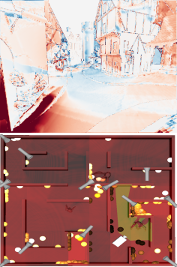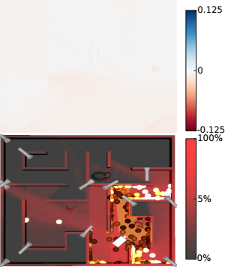Sequential Monte Carlo Instant Radiosity
andACM SIGGRAPH Symposium on Interactive 3D Graphics and Games | I3D 2016
 |
 |
 |
 |
| Keller [1997] | Barák et al. [2013] | Segovia et al. [2007b] |
Our method
|
| Top: Temporal stability. The images show the difference between two consecutive frames in the Citadel scene (© Epic Games) where the light is moving. Our method (right) keeps the illumination stable. Bottom: An overhead view of a scene, the light sources, the camera and the virtual point lights (VPLs). The red tint indicates the fraction of VPLs illuminating a given point. The view frustum is denoted by the green/yellow region. Our method and Segovia et al. [2007b] only place VPLs where they illuminate surfaces visible to the camera. |
Abstract
Instant Radiosity and its derivatives are interactive methods for efficiently estimating global (indirect) illumination. They represent the last indirect bounce of illumination before the camera as the composite radiance field emitted by a set of virtual point light sources (VPLs). In complex scenes, current algorithms suffer from a difficult combination of two issues: it remains a challenge to distribute VPLs in a manner that simultaneously gives a high-quality indirect illumination solution for each frame, and does so in a temporally coherent manner. We address both issues by building, and maintaining over time, an adaptive and temporally coherent distribution of VPLs in locations where they bring indirect light to the image. We introduce a novel heuristic sampling method that strives to only move as few of the VPLs between frames as possible. The result is, to the best of our knowledge, the first interactive global illumination algorithm that works in complex, highly-occluded scenes, suffers little from temporal flickering, supports moving cameras and light sources, and is output-sensitive in the sense that it places VPLs in locations that matter most to the final result.
BibTeX
@INPROCEEDINGS{HedmanI3D2016,
author = {Hedman, Peter and Karras, Tero and Lehtinen, Jaakko},
title = {{Sequential Monte Carlo Instant Radiosity}},
booktitle = {Proceedings of the ACM SIGGRAPH Symposium on Interactive 3D Graphics and Games},
publisher = {ACM},
year = {2016}
}
Acknowledgements
We thank Timo Aila, Samuli Laine, Tobias Ritschel, Perttu Hämäläinen, Clément Godard, Corneliu Ilisescu, Moos Hueting, Daniel Worrall and Stefan Garbin for brainstorming and helpful comments. Thanks to Lars Hedman for help with the text and his support. Thanks to Epic Games for Citadel and Erik Sintorn for help with it. Thanks to Marko Dabrovic for Sibenik, Frank Meinl for Crytek Sponza, the U.C. Berkeley WALKTHRU project for Soda Hall and the Stanford Computer Graphics Lab for Bunny and Armadillo. This work was partly funded by the EU project CRPLAY (no 611089) www.cr-play.eu, and EPSRC EP/K023578/1.

 Preprint PDF (12MB)
Preprint PDF (12MB)
 Slides (226MB)
Slides (226MB)